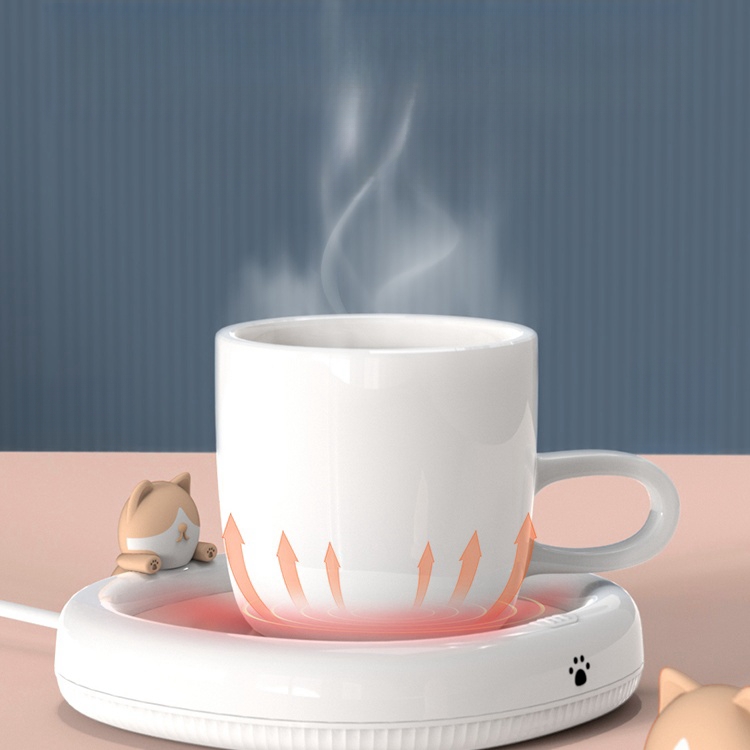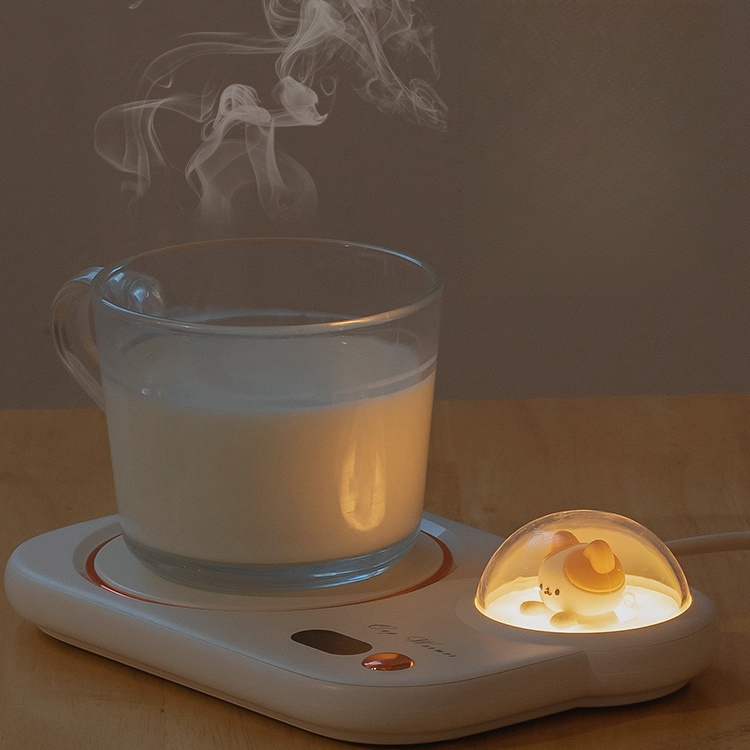Coffee is a staple drink for many people around the world. There’s something about that hot, rich, caffeinated beverage that helps kickstart our days and keeps us going.
But often we get distracted or called away from our morning coffee only to return to a lukewarm or cold cup. What a waste! This is where coffee warmer coasters come in handy.
These ingenious devices help keep your coffee piping hot for much longer than normal. But how do these coasters seemingly defy physics and keep hot beverages hot without continued heating?
Let’s take a closer look at the magic behind coffee warmer coasters and the technology that makes them work their thermal wonders.

The Importance of Temperature for Coffee
Before we dig into the inner workings of coffee warmer coasters, it’s helpful to understand why temperature is so important when it comes to brewing and drinking coffee in the first place. The ideal serving temperature for coffee is between 155°F and 175°F. This is because:
Chemistry Behind Extraction
- When water is heated to around 200°F during brewing, it can properly extract the desired flavor compounds like oils and polyphenols from the coffee grounds. As coffee cools, these compounds condense and the flavor is altered.
- The hot water facilitates the solubility and extraction of these coffee oils and other flavor molecules. Cooler water won’t dissolve and extract the compounds as readily.
- Higher temperatures also speed up the rate of extraction from the coffee grounds, but boiling or scalding temperatures can extract undesirable bitter compounds.
Burn Risks
- Serving coffee above 175°F poses a burn risk as liquids in this heat can cause severe, instant thermal burns.
- Coffee served between 140-149°F can still cause burns in 2-7 seconds. At 130°F, it may take a full minute of exposure to get a burn.
- Laws in many states require restaurants to serve coffee at temperatures not exceeding 135-140°F to minimize burn hazards.
Optimal Drinking Temp
- The tongue’s receptors perceive the most nuances and complexity of flavors in coffee served between 155°F and 175°F. Outside this range, the flavors become muted.
- When coffee is too hot, the heat overwhelms the tongue’s ability to taste the individual notes and flavors.
- As coffee cools below 155°F, the aromatics and volatile compounds that shape the flavor dissipate more rapidly.
- So in short, temperature is crucial for making coffee taste its best and drink safely! Coffee coasters help maintain the ideal temp longer.
The Technology Behind Coffee Warmer Coasters
There are a few different technologies used in coffee warmer coasters that help them conservatively maintain hot beverage temperatures. Here are some of the most common methods:
Phase Change Materials (PCMs)
Most coasters use phase change materials, or PCMs, to absorb and slowly release heat. PCMs are materials like paraffin wax, salt & mineral composites, or acrylic polymers that can store and release large amounts of thermal energy as they melt and solidify at certain temperatures. Here’s how PCM coasters utilize this technology:
- The PCM inside the coaster melts by absorbing heat once a hot mug is placed on top of it. The liquid PCM has a high heat capacity and latent heat of fusion, allowing it to absorb substantial thermal energy as it changes phase from solid to liquid.
- As the beverage’s temperature drops, the melted PCM begins solidifying again. This phase change from liquid back to solid releases the absorbed latent heat, gently warming the mug/beverage and maintaining the target temperature.
- The PCM is engineered to melt and solidify within the ideal coffee-drinking temperature range of 155°-175°F through precise material selection and molecular engineering.
- This PCM thermal battery cycle results in a consistent, controlled release of just enough heat energy to approximately balance the heat loss from the cooling beverage above.
- Common PCMs used include salt hydrates, paraffinic hydrocarbons, fatty acids, and esters due to their favorable melt points and energy storage density.
Electric Heating Elements
Some coffee coasters are plugged in and contain electric heating elements. These heaters use a low-wattage heating coil (usually less than 10 watts) powered by an AC adapter or USB cable to gently warm the coaster surface from below and maintain heat.
- This method continuously compensates for heat loss from the mug to the surroundings using an electrical energy input, keeping the coaster surface warm.
- Internal thermostats, thermistors, or timers are often used to regulate the heating element and prevent overheating above ~150°F.
- Compared to active mug warmers, electric coasters use lower wattages and distribute heat more evenly and gently.
Insulated Designs
Some coasters simply have an insulated interior layer that retains heat and minimizes conductive heat transfer into the table or counter below the coaster.
- The insulated layer acts as a thermal barrier, limiting heat flow through the coaster bottom.
- Heat radiating upwards from the mug is trapped inside the coaster instead of dissipating out the bottom.
- Materials like neoprene, silicone, cork, or air gaps are used to provide low thermal conductivity.
- This passive insulation prolongs cooling by preventing downward heat losses.
- Insulated coasters lack active heating, so beverages cool faster than PCM or electric versions.

Advanced Materials for Enhanced Performance
In addition to the core technologies above, some high-end coffee coasters incorporate advanced materials to further improve their functionality:
- Graphite matrices – Some PCM coasters use graphite foam, nanosheets, or matrices to improve thermal conductivity and speed energy transfer to the mug.
- Metal layers – Aluminum or copper conductive films or plates distribute heat more evenly across the coaster’s surface.
- Ceramics – Ceramic compounds paired with PCMs provide thermal stability and durability to repeated melt/freeze cycles.
- Nanoparticles – Adding nanoparticles like graphene, carbon nanotubes, or metals to PCMs enhances heat capacity, stability and cycle life.
- Hydrogels – Super absorbent hydrogel pads allow coasters to absorb condensed moisture from the mug.
- Antimicrobials – Silver nanoparticles or other antimicrobials inhibit bacterial growth and odors in coasters over time.
These high-performance materials boost the efficiency and usage life of the coasters. However, they also raise costs compared to basic PCM & insulated models.
The Many Benefits of Coffee Warmer Coasters
Using a coffee warmer coaster provides several benefits for coffee drinkers who want to enjoy their drink long after it’s brewed:
- Maintains ideal coffee or tea drinking temperature of 155°F-175°F for an extended period of 30-90+ minutes.
- Prevents coffee from cooling too quickly before finishing your cup at your own pace.
- Allows taking a phone call, bathroom break, or pause without wasting coffee that cools down prematurely.
- Saves money by avoiding dumping unfinished cooled coffee and brewing fresh cups multiple times per day. A coaster quickly pays for itself.
- Provides consistent, even heating without hotspots or scalding risks that can occur with direct mug warmers.
- Portable designs with silicone grips allow keeping coffee hot in cars, at the office, or on the go.
- User-friendly, passive operation that works automatically without needing to actively plug in, monitor temperatures, or intervene.
- Safer than electric or candle warmers, which can pose fire hazards and use open flames. Coasters operate at safe, moderate temperatures.
- Cleaner option compared to messy candles which can drip wax, emit smoke or odors and require maintenance.
For those who like to slowly savor piping hot coffee, tea, or hot chocolate while reading, working or relaxing, a coffee coaster is a simple way to indulge without rushing to finish your drink while it’s still warm. The coaster does thermal heavy lifting!

Factors that Impact Heat Loss from Coffee
To best understand how coffee coasters work their magic, it helps to consider the various factors that make hot coffee lose heat so quickly under normal circumstances:
- Material properties – Porcelain ceramic mugs have very low insulation value. Most heat flows freely through the mug walls.
- Surface area – Coffee has a large exposed surface area in a mug, allowing heat to dissipate into the surroundings.
- Temperature differential – The bigger the temperature difference between the hot coffee and the cooler room, the faster heat transfers out.
- Evaporation – Hot coffee continuously evaporates, pulling heat away. As the liquid evaporates, vapor carries energy with it.
- Radiation – Hot objects release infrared radiation, emitting thermal energy into the environment. Radiative heat losses increase exponentially with temp.
- Convection – Air currents carry heat away from the mug surface as hot coffee heats the adjacent air causing it to rise.
- Conduction – Direct contact with cooler table surfaces conducts heat out of the mug’s bottom.
Coffee coasters counteract these losses by providing insulation, maintaining an artificial heat source via PCMs or electric input, minimizing evaporative area, and retarding convection.
Choosing the Best Coffee Warmer Coaster
When selecting a coffee warmer coaster, there are a few factors to consider based on your preferences:
- Heating mechanism – Both PCM and electric options work well. PCMs don’t require power but lose efficacy over 1-2 years. Electricity provides renewable heat.
- Heat duration – Hour+ heat retention requires excellent insulation and thermal mass, which often increases coaster height. Determine the desired duration.
- Safety features – Ensure overheat protection and auto-shutoff. Avoid models that lack temperature regulation or have exposed heating elements.
- Dimensions – Consider mug clearance so handles don’t extend beyond the coaster perimeter. Large diameters accommodate mug movement.
- Portability – Compact, lightweight silicone coasters are highly portable. Bulkier designs stay put.
- Maintenance – PCMs may need periodic recharging by heating in an oven. Electric models require little maintenance.
- Cost – Prices span from $10 to $50+. Higher prices can indicate advanced materials and heating technology.
- Reviews – Verify excellent real-world reviews from other coffee drinkers. Beware models with quality control issues.
- Warranty – Multi-year warranties provide peace of mind and support/replacements for defects.
- With diligent shopping, you can find an affordable, well-made coffee coaster that reliably keeps your morning coffee or tea at just the right sipping temperature for however long it takes you to finish your cup and start your day.
After testing out one of these clever coasters for yourself, you may wonder how you ever forced down lukewarm coffee again!













